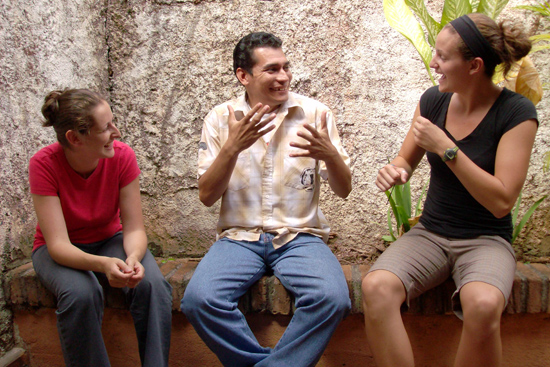Psychology Faculty, Student Study Emerging Sign Language in Nicaragua
 |
| Anna Shusterman, left, and Lisa Drennan ’09 speak to a Deaf man by using Nicaraguan Sign Language. The language is only 30 years old. |
| Posted 09/04/08 |
| In the United States, Deaf people have had the ability to communicate by using sign language since the early 1800s. But in Central Americas largest nation of Nicaragua, the Deaf community had no formalized language until 30 years ago.
This emerging language, known as Nicaraguan Sign Language, is the topic of a recent study by Anna Shusterman, assistant professor of psychology, and psychology major Lisa Drennan 09. The language was first created by local children to communicate with their friends and family and is rapidly changing. Nicaraguan Sign Language is certainly not a hodge-podge of different sign languages it has its own structure, its own grammar, its own phonology, and its own words, Shusterman says. So its of great interest to researchers who are interested in the birth and evolution of language. Shusterman, whose broader research focuses on the development of language and thought, works with the Deaf community in Managua, Nicaragua to understand which cognitive capacities are spared despite limitations in language, and which cognitive capacities suffer when language is impaired. She invited Drennan to accompany her on a 10-day research trip in June. The evolution of Nicaraguan Sign Language (NSL or Idioma de Señas de Nicaragua) originated in the late 1970s when a government push in special education initiatives led to new educational centers that included Deaf children. Teachers instructed their pupils with simple finger spellings, but the children invented their own gestures to communicate to each other. This provides strong evidence that language acquisition is a “naturally emerging mental process,” Shusterman explains. With this natural ability, each new generation of children joins and contributes to the increasing complexity of the language. “An interesting side effect of the rapid evolution of this language is that the younger users of NSL have more sophisticated language than the older people,” Shusterman says. In Managua, Shusterman and Drennan studied the sign language differences between three age groups of Deaf people who attended, or are currently attending the schools for special education. Previous researchers had discovered an inverted linguistic community, where the older NSL signers use a less complex form of the language, while the younger people use the form with the most recent changes and adaptations. For this reason, Shusterman and Drennan focused on the significant language differences between people in their 20s and those in their 30s. “The desire for humans to communicate with one another was so apparent, and especially with Deaf people, there really tends to be a great desire to communicate with as many people as possible, and in any way possible, Drennan observed. Shusterman and Drennan studied visual perspective-taking skills in young and older Deaf participants. Visual perspective taking is an important cognitive skill that is essential for signing. The study revealed that younger signers had a far better ability to visually imagine what something looks like from another viewpoint. They also tested cognitive function by asking the signers to control, plan, and direct their thoughts—a collection of skills known as “executive function.” They asked their participants to play a simple game in which they have to say “day” if they see a picture of a moon and “night” if they see a sun, a task which requires them to suppress the automatic response of saying “day” for sun. This ability might be related, for example, to suppressing your own perspective in order to think about or talk about somebody else’s perspective, Shusterman explains. Her broader goal is to sort out how these cognitive abilities relate to each other and to language. Prior to the trip, Drennan already took three semesters of Spanish, four semesters of American Sign Language, and one semester of Shusterman’s advanced research in developmental psychology. But learning Nicaraguan sign language was a skill acquired on the job. Just by being immersed in Nicaraguan sign language, I was able to pick up a lot of important words that made it possible for me to have small conversations with Nicaraguan signers, Drennan explains. I am specifically fascinated with Nicaraguan Sign Language because its such a young language with an unusual community. And as a psychology major, I really enjoy studying how the uniqueness of the language affects certain aspects of the Nicaraguan signers development. The study was funded by a Mellon Career Development Grant and Wesleyan research funds. Shusterman, who conducted past studies in 2005 and 2007, plans to continue the research in upcoming years here at Wesleyan. Shusterman is collaborating with Jennie Pyers, assistant professor of psychology at Wellesley College, and Ann Senghas, associate professor of psychology, at Barnard College. She and Drennan are in the process of analyzing their data, and they plan to write a paper on their findings. Shusterman has already presented results of past studies at conferences. The language is still changing and there are still so many questions to answer, and I always have more questions I want to investigate, especially in the critical transition between the 30- and the 20-year-olds, Shusterman says. I also feel a responsibility and a connection to the community there. These are people whom I remember and who remember me from one visit to the next, and it is a uniquely wonderful community in which to study the scholarly questions that interest me. |
| By Olivia Drake, The Wesleyan Connection editor. Photo contributed. |

